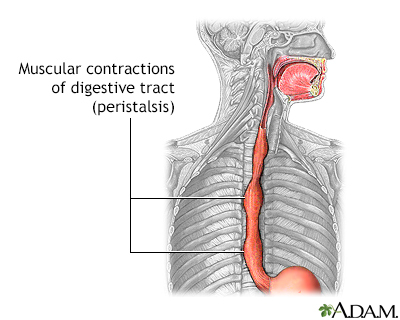Peristalsis
Definition
Peristalsis is a series of muscle contractions. These contractions occur in your digestive tract. Peristalsis is also seen in the tubes that connect the kidneys to the bladder.
Peristalsis is an automatic and important process. It moves:
- Food through the digestive system
- Urine from the kidneys into the bladder
- Bile from the gallbladder into the duodenum
Peristalsis is a normal function of the body. It can sometimes be felt in your belly (abdomen) as gas moves along.
Alternative Names
Intestinal motility
Gallery




References
Hall JE, Hall ME. General principles of gastrointestinal function - motility, nervous control, and blood circulation. In: Hall JE, Hall ME, eds. Guyton and Hall Textbook of Medical Physiology. 14th ed. Philadelphia, PA: Elsevier; 2021:chap 63.
Merriam-Webster's Medical Dictionary. Peristalsis. www.merriam-webster.com/medical. Accessed July 18, 2022.